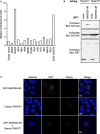Exploring type I interferon pathway: virulent vs. attenuated strain of African swine fever virus revealing a novel function carried by MGF505-4R
- PMID: 38529285
- PMCID: PMC10961335
- DOI: 10.3389/fimmu.2024.1358219
Exploring type I interferon pathway: virulent vs. attenuated strain of African swine fever virus revealing a novel function carried by MGF505-4R
Abstract
African swine fever virus represents a significant reemerging threat to livestock populations, as its incidence and geographic distribution have surged over the past decade in Europe, Asia, and Caribbean, resulting in substantial socio-economic burdens and adverse effects on animal health and welfare. In a previous report, we described the protective properties of our newly thermo-attenuated strain (ASFV-989) in pigs against an experimental infection of its parental Georgia 2007/1 virulent strain. In this new study, our objective was to characterize the molecular mechanisms underlying the attenuation of ASFV-989. We first compared the activation of type I interferon pathway in response to ASFV-989 and Georgia 2007/1 infections, employing both in vivo and in vitro models. Expression of IFN-α was significantly increased in porcine alveolar macrophages infected with ASFV-989 while pigs infected with Georgia 2007/1 showed higher IFN-α than those infected by ASFV-989. We also used a medium-throughput transcriptomic approach to study the expression of viral genes by both strains, and identified several patterns of gene expression. Subsequently, we investigated whether proteins encoded by the eight genes deleted in ASFV-989 contribute to the modulation of the type I interferon signaling pathway. Using different strategies, we showed that MGF505-4R interfered with the induction of IFN-α/β pathway, likely through interaction with TRAF3. Altogether, our data reveal key differences between ASFV-989 and Georgia 2007/1 in their ability to control IFN-α/β signaling and provide molecular mechanisms underlying the role of MGF505-4R as a virulence factor.
Keywords: African Swine Fever Virus; IFN; TRAF3; viral immune evasion; virulence factor.
Copyright © 2024 Dupré, Le Dimna, Hutet, Dujardin, Fablet, Leroy, Fleurot, Karadjian, Roesch, Caballero, Bourry, Vitour, Le Potier and Caignard.
Conflict of interest statement
The authors declare that the research was conducted in the absence of any commercial or financial relationships that could be construed as a potential conflict of interest.
Figures






References
Publication types
MeSH terms
Substances
LinkOut - more resources
Full Text Sources
Research Materials
Miscellaneous

